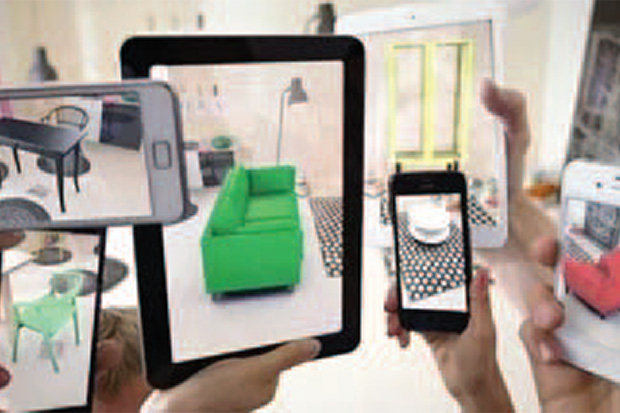
There's no doubt that Augmented and Virtual Reality (AR & VR), like all new technologies are becoming cheaper and more effective as the months pass. In "The future of learning & performance enhancement – part 1: Virtual" on April 9, 2018, we pointed out that we can begin to expect many more interesting use cases and growing market for these technologies because they are entering what the research and advisory company Gartner have coined as "The Plateau of Productivity." Essentially, the initial hype and novelty of AR & VR has worn off. Now businesses will explore practical uses of these tools with a pragmatic mind-set and more sober expectations.
The difference between Virtual Reality and Augmented Reality
Interestingly the market size for augmented reality is predicted to be 3 times as great as virtual reality and this trend should also carry into the learning and development arena. This is because while AR and VR both require a human being to be connected to a computer interface integrated with a back-end data base, AR is designed to enhance performance by providing just-in-time access to distributed intelligence and knowledge bases while the user is on the job. Virtual Reality, in general, only simulates on-the-job situations so that skills practiced can transfer into real life. If you've ever watched the blue dot on your map application to find out which direction you're walking in, or seen your nieces put on a pair of virtual bunny ears during a video chat, then you've experienced a lightweight version of augmented reality in which the capabilities of human intelligence and sensory perception are extended, and therefore performance, enhanced.
What makes AR So "hot"?
AR is attractive in the training space because it better enables humans to interact with the vast stores of data, documentation and technical specifications businesses regularly have at their disposal. It can do this without taking staff out of the office and losing productivity to lengthy training sessions. With a one-time cost of under US$1,000 for a Google Glass, employers can benefit from dramatically increased efficiency. Some estimates include increasing aerospace manufacturing accuracy to 99.9%, reducing maintenance travel costs by 60%, reducing healthcare readmissions by 30%, and increasing warehouse picking and packing efficiency by 25%. Furthermore, unlike traditional training, the AR assets investments remain with the company and can be used to accelerate the onboarding of new staff while tracking their performance and providing potential areas for improvement.
Case example – AR in beverage manufacturing
At bottling plants filler machines are used to put soda into cans and bottles. If these machines malfunction the whole production line slows or shuts down and a technician needs to be called in from the filler's manufacturer to fix the machine. Google Glass's Skylight software platform can be used to increase operational efficiency. In this case, technicians would have access to each machine's maintenance records and schematics in a heads-up display. They can consult materials while conducting diagnostics and repairs. When required, the AR enables video connectivity with remote experts who can inspect machines through a video interface, and can confer with local technicians to trouble shoot and resolve problems.
Case example – AR in aerospace
Boeing is always looking for ways to improve the overall quality and accuracy of its manufacturing processes, and the efficiency associated with reducing time to their completion. Just as the sheer complexity of avionics has increased, so has the knowledge and skill required to be a first-rate operator. Installing electrical wiring on an aircraft is a complex task that leaves no room for error. Traditionally, technicians had to look at and interpret two-dimensional twenty-foot-long drawings and construct that image in their mind while attempting the feat. That's a lot of data to keep in mind, especially when working in an industrial setting with lots of distractions.
To speed execution and reduce/eliminate manufacturing defects, Boeing is testing the use of augmented reality as a way to enable technicians with real-time, hands free, interactive 3D wiring diagrams, again using Google glass to provide a heads up display of critical performance support data, right before their eyes. "By using AR technology, technicians can easily see where the electrical wiring goes in the aircraft fuselage. They can roam around the airplane and see the wiring renderings in full depth within their surroundings and access instructions via voice commands, hands free," says Paul Davies of Boeing. While still in the pilot phase, they have been able to improve productivity by 40%, reduce defects and increase operator confidence and self-efficacy.
Conclusions
The importance of human-technology partnerships is nothing new. Augmented reality enables hands-on workers to benefit from the same distributed intelligence databases and user interfaces that have contributed to the explosion in productivity for knowledge workers over the past decades. Beneficial uses for this new technology include:
- Integrating performance support with common workplace tools & software;
- High precision computer vision that can understand and track the surrounding environment, to provide real-time updates assisting in critical thinking and problem solving;
- Providing real-time, expert video support "in the field" or anywhere in the world;
- Capturing high-volume "on the ground" performance data that, when analysed, generate insights that can be used to further increase efficiency.
The huge potential of this new technology and the relative inexpensiveness of the hardware makes AR a very promising field to explore for anyone interested in improving employee capability and operational efficiency.
Authors: Ronald Kantor and Justin Paul, are Talent Management Consultants at Latchmere Performance Solutions Co. Ltd. Ronald Kantor (Ron@LatchmereSolutions.com) is a Senior Solutions Architect Ph.D. in Education & Human Development, Justin Paul (Justin@Latchmereconsulting.com) has helped executives in over 30 countries improve leadership capability.
Series Editor: Christopher F. Bruton is Executive Director of Dataconsult Ltd, chris@dataconsult.co.th. Dataconsult's Thailand Regional Forum provides seminars and extensive documentation to update business on future trends in Thailand and in the Mekong Region.